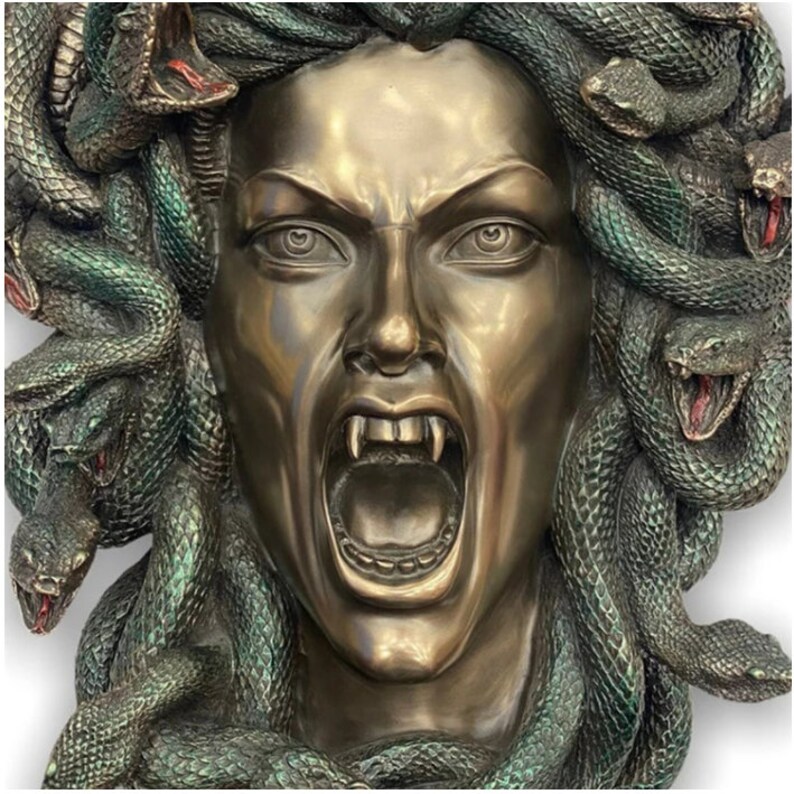

In the Roman poet Ovid’s version, Medusa had once been a beautiful maiden. Perhaps reflecting the fear men had-and truthfully, often still have-of being sucked into a relationship because of the irresistible attractions of females, Medusa was portrayed as both deceptively beautiful and hideously ugly of these three, however, Medusa was the only mortal Gorgon. Credit: Sailko/Wikimedia Commons/ CC BY-SA 3.0

Anyone who looked any of these powerful female figures straight in the face would turn to stone.Ī Roman cameo of Medusa. Some believe all the Gorgons, the trio of winged females with venomous snakes for hair, descended from Gaia, the personification of Earth herself. Perseus somehow manages to do the Medusa in-but only with the help of magical tools including winged sandals from Hermes an invisibility cap of invisibility from Hades, the god of the underworld, and a mirror-like shield that belonged to Athena, the goddess of wisdom and war. It does seem to beg the question of why all the female monsters in Greek mythology are killed by men. Interestingly, much like the Sphinx, Scylla, and Charybdis of Greek mythology, Medusa ends up meeting her maker at the hands of a male hero. A Gorgoneium Cup on the Tondo of an Ancient Greek Attic black-figured cup, end of sixth century BC-Cabinet des médailles de la Bibliothèque nationale de France, Paris, France. In Ovid’s work, Metamorphoses, from the first century AD, Medusa was portrayed as a terrifying Gorgon whose serpentine locks of hair turned anyone who met her gaze into stone. Naturally, the Romans adopted the Medusa as part of their mythology, as well. The 2nd century BC novelist, Dionysios Skytobrachion, places her somewhere in Libya, where Herodotus had said the Berbers created her story and image as part of their religion. Credit: Xocolatl /Wikimedia Commons/ Public DomainĪccording to Hesiod and Aeschylus, Medusa lived and died on an island named Sarpedon, somewhere near Cisthene. It was shown, for instance, on the Alexander Mosaic and the Gonzaga Cameo. Among other attributes, it was assumed by the rulers of the Hellenistic age as a royal aegis that implied divine birth or protection. It established their descent from earlier deities who were thought to remain powerful.

In Ancient Greece, the Gorgoneion was a special apotropaic amulet portraying the Gorgon head used most famously by the Olympian deities Athena and Zeus both of whom are purported to have worn it as a talisman and are often depicted wearing it. Credit: Dr.K./Wikimedia Commons/ CC BY-SA 3.0 Here, Medusa is shown wearing a belt made of snakes. In this section of the book, Ovid gives a completely different origin story for the terrifying creature.The Gorgon Medusa as portrayed on the pediment of the temple to Artemis on Kerkyra (Corfu). However, there is evidence that the myth changed drastically over time.Īround 8 AD, Ovid-a Roman poet celebrated for his faithful retelling of popular Greek myths-produced his famous Metamorphoses, an expansive book of myths which includes the myth of Perseus and his slaying of Medusa. In these earlier myths then, it’s assumed that Medusa was born a monster-complete with snakes and stony vision. He also describes a key difference between Medusa and her two sisters, one that becomes extremely important later: Medusa, unlike the other two gorgons (and for reasons not explained), is fully mortal. He calls them Stheno (“the mighty”), Euryale (“the wide wandering” or “the far springer”), and finally, Medusa (“the cunning one” or “the queen”). Hesiod, in his Theogony (700 BCE), describes the gorgons as three sister-monsters born of Phorcys and Ceto, two primordial ocean deities. It isn’t until several years later that another author gives the gorgon more of a backstory. In the Odyssey, the gorgon is a briefly mentioned inhabitant of the underworld-one whom Persephone could apparently “sic” on anyone who angered her.


 0 kommentar(er)
0 kommentar(er)
